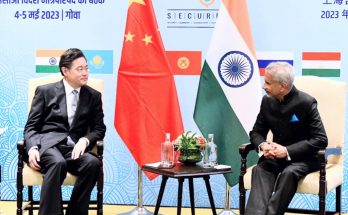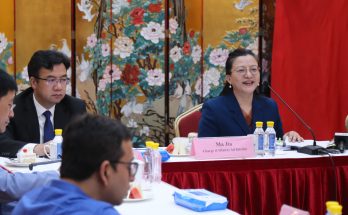 In November 2012, soon after the conclusion of the 18th National Congress of the Communist Party of China (CPC), President Xi Jinping put forward for the first time the idea of the Chinese Dream. In March 2013, Xi further elaborated on this concept at the closing ceremony of the First Session of the 12th National People’s Congress. Xi’s concept of the Chinese Dream is that the Chinese people should enjoy better education, more stable employment, higher incomes, greater degree of social security, better medical and health care, improved housing conditions, a better environment, satisfactory jobs and live better lives. In foreign affairs, Xi has emphasized that the Chinese Dream stands for peace, development, cooperation and mutual benefit for all. These are all very unexceptional sentiments expressed by any national leader and few can disagree with Xi’s laudable intentions. But what is the position on the ground and how is China faring under Xi Jinping in the achievement of these goals?
In November 2012, soon after the conclusion of the 18th National Congress of the Communist Party of China (CPC), President Xi Jinping put forward for the first time the idea of the Chinese Dream. In March 2013, Xi further elaborated on this concept at the closing ceremony of the First Session of the 12th National People’s Congress. Xi’s concept of the Chinese Dream is that the Chinese people should enjoy better education, more stable employment, higher incomes, greater degree of social security, better medical and health care, improved housing conditions, a better environment, satisfactory jobs and live better lives. In foreign affairs, Xi has emphasized that the Chinese Dream stands for peace, development, cooperation and mutual benefit for all. These are all very unexceptional sentiments expressed by any national leader and few can disagree with Xi’s laudable intentions. But what is the position on the ground and how is China faring under Xi Jinping in the achievement of these goals?
There are two very contrasting evaluations of China-2015 and the progress of the Chinese Dream. The first view is that China is well on its way to becoming the next pre-eminent power by overtaking the United States. This is supported by the following:
Based on current growth rates, the International Monetary Fund estimates that China’s GDP [in PPP terms] has already overtaken that of the United States. China’s GDP is US $17.6 trillion as compared to that of the United States at $ 17.4 trillion. Further, by 2019, the Chinese economy would be $26.98 trillion as compared to that of the United States at $22.3 trillion; in effect, the Chinese economy would be 20 per cent larger than that of the United States. 1 Secondly, China became the largest trading nation in the world in 2013, having overtaken the US.2 Thirdly, Chinese dominance is assured with the Yuan beginning to compete with the dollar as the world’s reserve currency. Fourthly, as China’s economy powers ahead, so will its defence build-up; with China’s defence expenditure surpassing that of America’s by 2035. To illustrate the coming Chinese dominance in the world, Arvind Subramaniam outlines a hypothetical scenario set in February 2021 of an American president going to the office of the Chinese head of IMF to sign for a $ 3 trillion emergency financing.3
In sharp contrast, the second view disputes the above conclusion and in support makes the following assertions:
 That China’s remarkable growth so far was primarily export-driven and for which purpose it utilized low-cost labor to develop the three sectors of manufacturing, real estate and infrastructure development. But its high growth rates are a thing of the past as its main export markets – the US, the EU and Japan – are constricting. Urgent market oriented reforms, although stressed at recent plenums, have not yet been implemented on the ground, which raises questions about China’s ability to maintain its high growth rate.
That China’s remarkable growth so far was primarily export-driven and for which purpose it utilized low-cost labor to develop the three sectors of manufacturing, real estate and infrastructure development. But its high growth rates are a thing of the past as its main export markets – the US, the EU and Japan – are constricting. Urgent market oriented reforms, although stressed at recent plenums, have not yet been implemented on the ground, which raises questions about China’s ability to maintain its high growth rate.
In China, the single most important driver of growth has been the real estate sector, which has witnessed heavy investment and has consistently maintained growth rates of about 20 per cent per year. For example, China has built over 700 five star hotels with another 500 under construction, and 470 sky scrapers with another 332 under construction. Five of the ten tallest buildings under construction in the world are in China.4 With the real estate bubble about to burst, the government has been forced to clamp down on this sector. As a result, the growth of investment in the real estate sector has fallen drastically to just 12.6 per cent in 2014.5 This, in turn, has led to a near collapse of the steel industry since a large proportion of economic activity is linked to real estate development. China built steel mills with an overall capacity of one billion tons – almost half the world’s total. A number of these now face the prospect of closure. A similar situation, of large scale overcapacity, exists in many other manufacturing sectors.
Local government debt, already huge, will be further compounded by the economic slowdown. It is estimated that up to 20 or 25 per cent of these loans may prove to be non-performing, amounting to losses of between six and 10 per cent of GDP.6 The rich seem to be voting with their feet by emigrating; an estimated 14 per cent whose net worth is more than $ 10 million have already left the country.7 Despite restrictions imposed by the Bank of China on capital currency movement, an estimated $ 3.77 trillion has moved out of China in the last decade.
With economic growth projected to slow down, the primary issue that China faces is internal security. There are tens of thousands of riots every year mainly in the rural areas, provoked by land seizures by corrupt officials. There are about 200 million internal migrant workers who are often denied health care facilities or schooling on par with local residents. This has led to glaring ‘inequality.’ The Gini co-efficient for China, the internationally accepted measure of inequality within a country, stood at 0.45 about a decade ago [0.44 indicates looming social unrest], the highest for any Asian country. 8 Now this figure is approaching 0.73.9
The prevalence of inequality in China is further highlighted by the fact that the richest one per cent own one-third of the country’s wealth, whereas the poorest 25 per cent own only one percent!10 China now has more millionaires – 643,000 – than any other emerging economy. This figure went up by 14.3 per cent from 2012.11 This income disparity has become a source of pervasive disgruntlement and seething social protest. No wonder China’s budget for internal security [$ 124 billion] is larger than its official defence budget [$ 119 billion].12 Public cynicism has considerably eroded mass support for the Communist Party.
According to the Transparency International Perception Index [TNI, 2014] of the most corrupt countries in the world, China’s position in the 176 country list has deteriorated from 80th last year to 100th this year; it is on par with Algeria and Suriname.13 This fall in position took place despite the state media reporting that nearly 75,000 cadres were in breach of ‘austerity measures’ [Chinese official code for corruption] and had been disciplined to root out corruption.
China’s population dividend is also fast disappearing. Although people aged 60 and above constitute only 14.9 per cent of the total population at present, by 2050 they will make up nearly 40 per cent of the population.14 Thus China will become an aging society with its accompanying economic fall-out as well as a worsening male/female ratio.
Environmental degradation is China’s most acute problem today. 16 out of the world’s 20 most polluted cities are in China. Nearly two-thirds of Chinese cities fail to meet even the national standards of air quality.15 Further, nearly 70 per cent of China’s two main rivers – the Yangtze and the Huang He – are polluted by illegal waste disposable practices. By 2007, China had surpassed the United States and is now responsible for one-third of the world’s output of green-house gases [GHG]. It is also the world’s largest emitter of carbon dioxide.
Given such dismal statistics, the protagonists of the pessimistic view aver that there is no way China can assume the mantle of the pre-eminent power in the world and challenge US military and economic supremacy. In essence, China may be a rising power but internally it is still very fragile. Which of these equally convincing scenarios will eventually prevail? President Xi has already recognized the inevitable when he stressed that China would adjust to the ‘new normal’ of lower growth and, to ensure stability, he has already cracked down on dissent and strengthened media control measures. Vice Premier Wang Yang last month told the China-US Joint Commission on Commerce and Trade [JCCT] that: “China and the US are global economic partners, but America is the guide of the world. America already has the leading systems and rules. China is willing to join the system and respect these rules and hopes to play a constructive role” [emphasis added].16 Has China already recognised the inevitable?
–The views expressed in this article are solely those of the author
– IDSA
1. Hugo Duncan and David Martosko, “America usurped: China becomes world’s largest economy – putting USA in second place for the first time in 142 years,” Mail Online, 9 October 2014, http://www.dailymail.co.uk/news/article-2785905/China-overtakes-U-S-world-s-largest-economy-IMF-says-economy-worth-17-6trillion-America-falls-second-place-time-1872.html
2. Angela Monaghan, “China surpasses US as world’s largest trading nation,” The Guardian, 10 January, 2014, http://www.theguardian.com/business/2014/jan/10/china-surpasses-us-world-largest-trading-nation
3. Eclipse: Living under the Shadow of China’s Economic Dominance (Peterson Institute of International Economics, 2011).
4. Yu Yongding, “China faces challenges but bears beware of betting on collapse,” East Asia Forum, 28 December 2014, http://www.eastasiaforum.org/2014/12/28/china-faces-challenges-but-bears-beware-of-betting-on-collapse/#more-44702
5. Clare Jim, “China housing inventories seen piling up in 2015 as supply grows,” Reuters, 14 January 2015, http://uk.reuters.com/article/2015/01/14/uk-china-property-inventory-idUKKBN0KN0F420150114
6. Satyajit Das, “China can’t rescue the world because its recent growth is largely illusion,” The Independent, 11 June 2013, http://www.independent.co.uk/news/business/comment/satyajit-das-china-cant-rescue-the-world-because-its-recent-growth-is-largely-illusion-7631310.html
7. Yanzhong Huang, “China: The Dark Side of Growth,” Yale Global, 6 June 2013, http://yaleglobal.yale.edu/content/china-dark-side-growth
8. Asian Development Bank Report 2007, http://www.adb.org/documents/adb-annual-report-2007
9. Jonathan Kaiman, “China gets richer but more unequal,” The Guardian, 28 July 2014
10. Ibid.
11. Lorraine Woellert and Sharon Chen, “China’s Income Inequality Surpasses U.S., Posing Risk for Xi,” Bloomberg News, 29 April 2014, quoting Asia-Pacific Wealth Report.
12. Ben Blanchard and John Ruwitch, “China hikes defense budget, to spend more on internal security,” Reuters, 5 March 2013, http://in.reuters.com/article/2013/03/05/us-china-parliament-defence-idUSBRE92403620130305
13. Euan McKirdy, “China Slips Down Corruption Perception Index, Despite High Profile Crackdown,” CNN, 3 December 2014, http://edition.cnn.com/2014/12/03/world/asia/china-transparency-international-corruption-2014/
14. National Bureau of Statistics of China, 24 February 2014.
15. Beina Xu, “China’s Environmental Crisis,” Council on Foreign Relations Backgrounder, 25 April 2014, http://www.cfr.org/china/chinas-environmental-crisis/p12608
16. Vice Premier Wang Yang’s statement to the US-China Joint Commission on Commerce and Trade on 27 December 2014.
Author Profile
- India Writes Network (www.indiawrites.org) is an emerging think tank and a media-publishing company focused on international affairs & the India Story. Centre for Global India Insights is the research arm of India Writes Network. To subscribe to India and the World, write to editor@indiawrites.org. A venture of TGII Media Private Limited, a leading media, publishing and consultancy company, IWN has carved a niche for balanced and exhaustive reporting and analysis of international affairs. Eminent personalities, politicians, diplomats, authors, strategy gurus and news-makers have contributed to India Writes Network, as also “India and the World,” a magazine focused on global affairs.
Latest entries
 DiplomacyApril 10, 2024Diplomat-author Lakshmi Puri pitches for women power at LSR
DiplomacyApril 10, 2024Diplomat-author Lakshmi Puri pitches for women power at LSR India and the WorldApril 6, 2024UN envoy pitches to take India’s solutions to the world stage
India and the WorldApril 6, 2024UN envoy pitches to take India’s solutions to the world stage CultureApril 5, 2024Youth in Diplomacy: Making it Matter with LSR Model UN 2024
CultureApril 5, 2024Youth in Diplomacy: Making it Matter with LSR Model UN 2024 India and the WorldMarch 28, 2024India to China: Normalization of troops deployment imperative for restoring ties
India and the WorldMarch 28, 2024India to China: Normalization of troops deployment imperative for restoring ties







